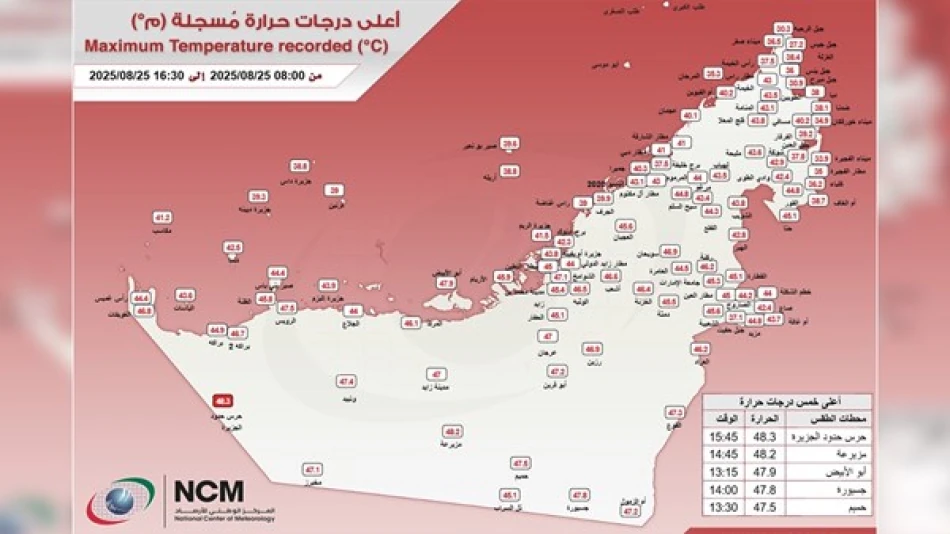
Sizzling Temperatures Soar in the UAE: Record-Breaking Heat Wave Hits the Emirates
UAE Swelters Under Near-Record Heat as Desert Temperatures Soar to 48.3°C
The United Arab Emirates recorded a scorching temperature of 48.3°C (119°F) on Monday, marking one of the highest readings of the year as the desert nation grapples with intensifying summer heat. The extreme temperature, registered at Al Jazeera Border Guard station in the Al Dhafra region at 3:45 PM local time, underscores the growing challenge of climate adaptation in one of the world's most heat-exposed countries.
Desert Interior Bears the Brunt of Extreme Heat
The Al Dhafra region, where Monday's peak temperature was recorded, represents the UAE's vast desert interior—an area that consistently experiences the country's most extreme weather conditions. This remote southwestern region, stretching toward the Saudi Arabian border, regularly sees temperatures climb above 45°C during the summer months, but Monday's reading approached the UAE's all-time temperature records.
The National Center of Meteorology's announcement via social media highlights how the country's weather monitoring infrastructure has become increasingly sophisticated, with border guard stations and remote outposts now serving as critical data collection points for climate tracking.
Regional Context: Gulf States Face Mounting Heat Stress
The UAE's extreme temperature reading places it alongside other Gulf nations experiencing unprecedented heat levels this summer. Kuwait and Saudi Arabia have recorded temperatures exceeding 50°C in recent weeks, while Iraq has seen sustained periods above 48°C, creating a regional pattern of intensifying heat stress.
Unlike coastal areas where humidity creates dangerous "wet bulb" conditions, the UAE's interior desert regions experience dry heat that, while still dangerous, allows for some natural cooling through evaporation. However, temperatures approaching 50°C pose significant risks even in low-humidity environments.
Economic and Infrastructure Implications
These extreme temperatures carry substantial economic consequences for the UAE's energy grid and infrastructure. Power consumption typically spikes by 15-20% during peak heat periods as air conditioning systems work overtime, placing enormous strain on the electrical grid despite the country's substantial generation capacity.
The construction and logistics sectors, which employ hundreds of thousands of outdoor workers, face mounting challenges in maintaining productivity while ensuring worker safety. UAE labor laws mandate work stoppages during peak afternoon hours when temperatures exceed certain thresholds, directly impacting economic output during summer months.
Climate Adaptation in a Vulnerable Region
The UAE's experience with extreme heat has positioned it as a testing ground for climate adaptation technologies. The country has invested heavily in district cooling systems, reflective building materials, and urban planning strategies designed to mitigate heat island effects in major cities like Dubai and Abu Dhabi.
Cloud seeding programs, which the UAE has pioneered in the region, become increasingly critical during such heat waves, though their effectiveness remains limited during the most extreme temperature events. The country's National Center of Meteorology operates one of the world's most advanced cloud seeding programs, conducting over 200 missions annually.
Looking Ahead: The New Normal
Monday's temperature reading, while extreme, represents what climate scientists increasingly describe as the "new normal" for Gulf states. Historical data shows that temperatures exceeding 48°C, once rare events occurring perhaps once or twice per summer, now happen multiple times each year across the region.
This trend has accelerated the UAE's transition toward renewable energy and energy efficiency measures, not just for environmental reasons but as a matter of economic and social stability. The country's ability to maintain livability while temperatures regularly approach 50°C will serve as a crucial test case for other heat-vulnerable regions worldwide.
Most Viewed News

 Layla Al Mansoori
Layla Al Mansoori






